Melbourne Tram Museum
- Follow Melbourne Tram Museum on Twitter
- Follow Melbourne Tram Museum on Facebook
- Follow Melbourne Tram Museum on Instagram
- Follow Melbourne Tram Museum on Pinterest
- Follow Melbourne Tram Museum on Tumblr
- Subscribe to Melbourne Tram Museum's RSS feed
- Email Melbourne Tram Museum
T.P. Strickland: designer of the W Class tram
Given the long rivalry between the cities of Melbourne and Sydney, it is somewhat ironic that the design of what became the iconic symbol of Melbourne – the W class tram – was the responsibility of a Sydneysider.
Tom Percival Strickland was born in Sydney on 12 October 1875 to Thomas Arthur and Annie (nee Mason) Strickland, as one of three children. The family resided at Dun Aros, Crescent Road, Manly [1]. His father was a merchant of note in Sydney commercial circles, being a partner in the firm of Young, Lark & Company of Moore Street. Tragically, Strickland’s father was the victim of a boating accident, drowning outside Sydney Heads on 3 June 1888.
Strickland was educated at Sydney Grammar and the University of Sydney, graduating with first class honours in a Bachelor of Engineering in 1897. He was active in both the tennis and cricket clubs, batting in the middle order for Sydney University second XI. On completing his degree, Strickland won a scholarship to study overseas, completing a Master of Science at McGill University, Montreal. There he was awarded the Governor-General of Canada’s medal for original research.
After completing his Master’s degree, Strickland gained practical electrical engineering experience during one year with the General Electric Company in Schenectady, New York. Subsequently he worked for a few months as Assistant Engineer at Greens Fuel Economizer Company [2], New York, before returning to Australia to take up an appointment in February 1902 as Assistant Engineer to the New South Wales Government Railways and Tramways. His competence and knowledge was quickly recognised by his new employer, as within a year he was promoted to Chief Assistant Electrical Engineer. That same year Strickland married Gertrude Hayes.
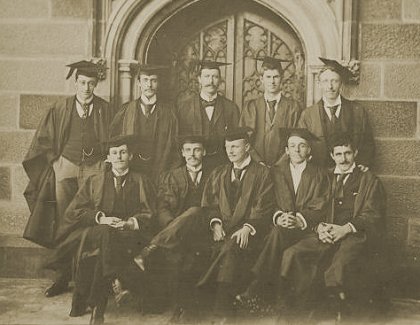 Sydney
University engineering students,1897. T.P. Strickland is in the front
row, second from the left.
Sydney
University engineering students,1897. T.P. Strickland is in the front
row, second from the left.- Photograph courtesy National Library of Australia
One of his projects in New South Wales was the conversion of the power distribution system of the Sydney tramway system to three-phase high voltage alternating current. During his time with the NSW Government Railways and Tramways Strickland also consulted to the Australian mining industry on storage battery technology.
Coming to Melbourne
In 1921, the proposal of the newly-created Melbourne and Metropolitan Tramways Board (M&MTB) to convert its large cable tram system to electric traction and expand its network of lines was an irresistible lure for any engineer of ambition in Australia. When the vacancy for the position of Chief Engineer was announced, Strickland was appointed against stiff opposition. He moved his family from their residence in the northern Sydney suburb of Wollstonecraft and started his new position on 5 October 1921, taking over from the Manager and Acting Chief Engineer H.S. Dix with an annual salary of £2000.
The challenges facing the new Chief Engineer were substantial. The Melbourne cable tram system – one of the largest in the world – was both overloaded and obsolete, while the suburban electric routes had been built by independent tramway trusts with no standardisation of tramcars or engineering practices – for example, the M&MTB had inherited 216 electric trams of twenty-one different designs. The cable tram system – unlike the electric systems of the former trusts – was highly standardised. It had been brilliantly designed and constructed between 1885 and 1891 under the direction of the engineer of the Melbourne Tramway & Omnibus Company (MTOC), George Smith Duncan.
Strickland was responsible for drawing up what was known as the General Scheme for conversion of the cable tram system to electric traction and the massive expansion of electric routes into the outer suburbs of Melbourne. While it was acknowledged that replacing cable trams with electric trams was the right decision, the method of power supply was not agreed, despite the 1911 Royal Commission on the Railway and Tramway Systems of Melbourne recommending the use of overhead trolley wires in any electrification scheme.
There was a core of resistance against the use of ‘unsightly’ overhead wires. The good citizens of Melbourne did not want their view of the sky above the streets to be cluttered with a mess of electrical cables. After all, the trams of London, New York and Washington were powered by conductors run in underground conduits, removing the need for overhead wires. There was a strong view amongst sections of the community that the existing cable tunnels could be inexpensively adapted to supply power to electric trams.
Strickland’s first challenge was determining the method of electrification to be used for the conversion of the cable tram routes.
Conduit tramways supplied current to trams via two fixed T-rails in a tunnel located between the running rails, one supplying the positive current feed, while the other was the negative current return. The T-rails were about 30cm apart and approximately 45cm below the street surface. A device called a plough applied two spring-loaded metal shoes against the electrical supply rails, powering the tramcar above via its attachment through the slot in the middle of the track.
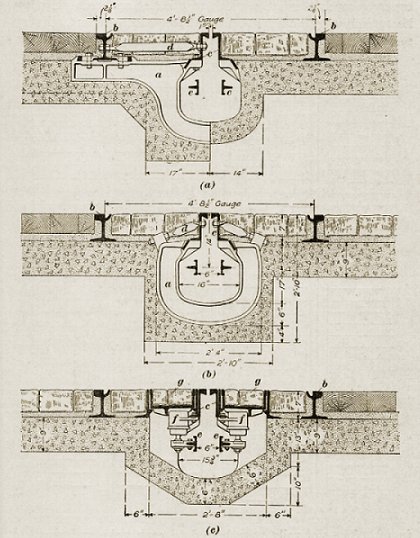 The three basic cross sections for conduit tramway track used by London
County Council. Top shows combined steel tunnel yoke and sleeper,
middle shows independent tunnel yoke, while bottom shows insulating
hangers for supporting the contactor T-rails. The plough ran in the
tunnel between the contactor t-rails, supplying traction current to
the tramcar via a connection through the slot.
The three basic cross sections for conduit tramway track used by London
County Council. Top shows combined steel tunnel yoke and sleeper,
middle shows independent tunnel yoke, while bottom shows insulating
hangers for supporting the contactor T-rails. The plough ran in the
tunnel between the contactor t-rails, supplying traction current to
the tramcar via a connection through the slot.- Image from Construction of Electric Tramways and Railways, ICS Reference Library.
There were a number of issues associated with the conduit method of electrification. Several cable tram routes in Melbourne traversed low-lying areas subject to flooding – most notably the Port Melbourne and South Melbourne routes. Special pumping arrangements were required to keep the cable tunnels free of water. However, the pumps were not always adequate, especially when high tides coincided with heavy rainfall. While these circumstances did not halt cable tram operation, a conduit supplied electric tramway could not function when tunnels were flooded.
Furthermore, maintenance and cleaning of tunnels was labour intensive, while experience from overseas conduit tramways showed that the voltage drop through current leakage to ground was sharper than that for overhead wire tramways. This resulted in greater power consumption and thus increased operating costs for conduit tramways. It also required additional substation machinery, increasing capital costs over those required by comparable overhead wire tramways.
 Cross section of cable tram track and tunnel used in Melbourne, showing
tunnel yoke, rails, slot beams and tie-rods. The track was supported
on a concrete raft, while the road surface was formed by red gum wood
blocks. Note the deeper cable tunnel compared to conduit track.
Cross section of cable tram track and tunnel used in Melbourne, showing
tunnel yoke, rails, slot beams and tie-rods. The track was supported
on a concrete raft, while the road surface was formed by red gum wood
blocks. Note the deeper cable tunnel compared to conduit track.- From an original MTOC drawing.
All the existing electric tramways in Melbourne had been built using overhead trolley wire to supply traction voltage to trams. They also shared the common characteristic of serving less densely populated suburbs of the city, as the projected lower patronage levels had made it unattractive for MTOC to extend the cable tram system into these areas. The reduced capital and operating costs of electric tramways supplied by overhead trolley wires over cable tramways was the rationale for their existence in the first place. Conversion of these outlying electric tram routes to conduit operation was guaranteed to generate substantial losses due to the inability of the routes to service debt from earnings.
Therefore, if the central cable tram system was to be converted to electric conduit operation, the options for individual tramcars would be:
- restricted to operation on conduit routes only;
- restricted to operation on overhead trolley wire routes only; or
- equipped to operate on both conduit and overhead trolley wire routes.
No matter which option was used, Strickland realised the result would be some capital inefficiency related to the provision of electric tramcars.
If the tram fleet was not designed to work both on conduit routes and overhead trolley wire routes, additional spare trams of each type would be needed to cover for both scheduled maintenance and unexpected breakdowns, increasing the overall capital cost.
Conversely, if tramcars were fitted to operate on both types of routes, their construction cost would be higher than if they were designed for a single type of route. Additionally, if this option was chosen, operational complexity would be introduced due to the need to switch over the method of tram current collection at transition points. Timetables would need to accommodate this changeover activity, and it would require additional staff [3] at transition points, increasing operational costs.
If a problem arose with a plough, the tram service had to be halted until the problem was resolved, as a faulty plough could cause serious (and expensive) damage to the conduit supply. This was more disruptive than comparable situations with tramcars operating on overhead trolley routes, such as a broken trolley pole, where a tram could be pushed by another to a point where it did not obstruct service.
All these factors were well understood – contemporary sources showed that conduit electric tramways were approximately double the capital cost of overhead trolley wire tramways. Strickland’s challenge was to show that the existing cable tram tracks and tunnels could not be easily and inexpensively adapted to conduit operation.
One of the promises offered by conversion to electric traction was the ability to run large single-deck bogie tramcars able to carry a crush load of up to 150 passengers. In comparison, the crush load for a standard Melbourne cable tram set was only 54 people, and it required the same number of crew to operate. To run these large bogie electric tramcars, heavier rail was required than that used by the cable trams, due to their substantially increased weight – 18 tonnes rather than the 5.3 tonnes of a standard Melbourne cable tram set.
Additionally, the large bogie tramcars had to be both longer and wider than the cable trams to accommodate the greater passenger load, which meant that the clearances between the tracks was insufficient, both on straight sections of tracks and curves. Maintaining the existing cable track clearances of the cable trams would mean that the new electric trams had to be shorter and narrower than desired, reducing carrying capacity and increasing crewing costs on a per-passenger basis.
Operating tall, short and narrow double deck trams like those used in London was not an option either, due to the number of low rail overbridges on the proposed routes. Additionally, the slow passenger loading characteristics of double deck trams made them operationally unattractive to a city used to the fast loading capability of the cable trams that were only barely able to meet the demands of Melbourne’s evening peak-hour traffic.
Therefore, to obtain the operating efficiencies required for the conversion to electric trams, the existing cable tram tracks could not merely be upgraded – they had to be reconstructed with wider clearances and heavier rail. This meant that the existing cable tunnels would be in the wrong position, thus the tunnels would have to be demolished and rebuilt if conduit supply was to be used, increasing costs enormously.
Strickland proved that the cost of conduit track was beyond the ability of the M&MTB to fund, given its remit to convert the cable tramways to electric traction and substantially expand the reach of the network.
Other methods of electrification were also examined, such as the Lorain surface contact system, or the use of battery-powered or petrol-electric tramcars, as well as substitution of trams with motor omnibuses or trolleybuses. These options were rejected for a variety of reasons, such as safety, inability to meet the projected traffic levels, and high operational costs. The M&MTB accepted Strickland’s recommendation that the cable tramways should be converted to the normal overhead trolley wire method of electrification, confirming the findings of the Royal Commission of 1911.
Developing the General Scheme
Development of the General Scheme required significant planning before a single sod of earth could be moved. Firstly, detailed population and traffic surveys were carried out to determine the areas of greatest demand – and hence financial return – for new electric tramways. These surveys were also used as a major input for deciding the priority of conversion of cable tram routes to electric traction.
Intensive survey work determined the most cost-effective routes for proposed lines. Many of the prospective routes were ill-suited to the construction of tramlines, due to poor urban planning. This was particularly the case in the northern suburbs of Melbourne, where the ad hoc decisions of land developers had left a legacy of narrow roads with frequent ‘dog-leg’ intersections, with no clear definition of major thoroughfares.
Detailed studies of land titles were necessary, as land resumptions would be required in order to straighten out and widen roads, and provide sufficient clearance for tramcars travelling around curves. In particular, the route followed by the future West Coburg line would show the influence of these factors – hence the sweeping curves it takes through the open space of Royal Park, and the several dog-legs it negotiates before it reaches Melville Road.
One of the factors to be considered was the avoidance of level crossings with Melbourne’s extensive suburban railway network, then undergoing a major electrification program of its own. When viewing all the initial proposals for new tramway routes, a total of 28 crossings of rail lines was noted if every proposed route was to be built, of which 21 were level crossings.
In order to meet this requirement, and the related need to cross watercourses, detailed designs for a total of 15 bridges and 9 subways were undertaken – although a feature of Melbourne’s tramways for decades to come would be level crossings with the electrified suburban rail system.
However, the works to implement the General Scheme did not just involve the conversion of the cable tram track, and construction of civil engineering works. Almost six hundred cable tram sets were used to carry passenger traffic. Sufficient replacement electric tramcars, as well as those for the planned expansion of routes, had to be designed and built. The new electric tram routes required construction of new electrical substations and power distribution networks, as well as expansion of the existing Malvern, Kew and Essendon Depots, and building of new depots in South Melbourne, Glenhuntly and Camberwell. These responsibilities all belonged to the Chief Engineer.
The Melbourne Tramway & Omnibus Company had established a major workshop in North Fitzroy, for the construction and maintenance of its cable tram rolling stock. The site and buildings were too small and cramped for the new generation of larger electric tramcars, while the machinery and equipment were obsolete, dating from the 1880s. It was also fully committed to maintaining the existing cable tram operation, and would be required to fulfil its existing role during the lengthy conversion of the system to electric traction.
None of the former electric tramways trusts had extensive workshops, relying on external car-builders for new trams. Given the projected expansion of the electric tramway system, and the expected size of the new fleet, new facilities would be required to support the future operations of the M&MTB. It was Strickland’s responsibility to determine the best site, settling on a greenfield location at the junction of the East and West Preston routes at the intersection of St George’s Road and Miller Street, Preston – across the road from the depot built by the former Fitzroy, Northcote & Preston Tramways Trust.
One of the key early decisions made by Strickland – with the support of the Chairman of the Board, Alex Cameron – was that the M&MTB would build its own electric tramcars. Therefore, the new Preston Workshops were designed and scaled not just for maintenance of a large tram fleet, but also to support the construction of up to eighty trams in a calendar year. The workshop buildings were designed by architect Alan G. Monsborough, and constructed over the period 1924 to 1928.
Designing the W
The M&MTB had inherited a fleet of 216 trams of twenty-one different designs. The majority of these were small capacity single truck trams, mostly of a type known as California combination cars, unsuited to the heavy loadings expected for peak hour city traffic.
What was required was a new standard design, one that improved on the passenger capacity of the cable trams, while replicating their fast loading and unloading characteristics. Given that staffing was a major component of tramway operating costs, it was imperative that the new design would be more cost effective than the standard Melbourne cable tram on a ‘per passenger’ benchmark.
The contemporary high capacity Sydney ‘P’ class toastrack tram – with which Strickland was intimately familiar – excelled in loading and unloading speed, as well in passenger carrying capacity, particularly when operating in coupled pairs. It was also thoroughly modern in terms of its electrical control systems, especially its multiple unit capability.
The open-sided nature of the Sydney ‘P’ class design would not meet favour in Melbourne’s cooler and damper climate. Strickland would have to come up with something more suitable. The most modern type on the Melbourne system, a group of six trams of a design known as bogie ‘drop centre’ cars [4] delivered in 1921, showed Strickland the way forward. These cars would form the basis of the new standard tram design.
However, the construction of the six cars was not optimised for mass production, being built by a timber merchant and furniture manufacturer in South Melbourne – James Moore & Sons. Hundreds of the proposed standard design would need to be delivered over the next few years. To reduce building cost, elaborations such as curved car sides and quarter windows were eliminated from the drop-centre design, setting the outline for new Melbourne tramcars for the next three decades.
In one aspect the new standard cars were a step backwards from the Sydney ‘P’ class trams – their electrical control systems. Foregoing the operational requirement for multiple-unit operation, the M&MTB standard tramcars were fitted with GE K35 direct control systems whose basic design was two decades old. This decision would have the consequence that multiple-unit operation of trams was never used in traffic in Melbourne. This was perhaps reinforced by a serious 1923 accident in Mount Alexander Road, Flemington Road, involving a collision between a heavily laden tram hauling an unpowered trailer and another tram. The cause of the accident was ruled to be failure to sufficiently apply the brake on the trailer car, which was not under the control of the driver.
One of the lesser innovations that Strickland introduced was the Sydney method of classifying electric trams into different classes by letter. The many different types of electric cars inherited from the pre-M&MTB tramways were allocated into classes A through V, leaving the first of the new standard cars to be classified into the W class, providing the lasting name for what would become the icon for Melbourne.
Strickland would be responsible for producing variations of the basic W class design into the W1, W2, SW2 [5], W3, W4, CW5 and W5 sub-classes, as well as the non-standard cars of the X1, X2, Y and Y1 classes. The W5 design would form the basis for all the subsequent W class trams built up until 1956, a few of which are still in regular service on the City Circle.
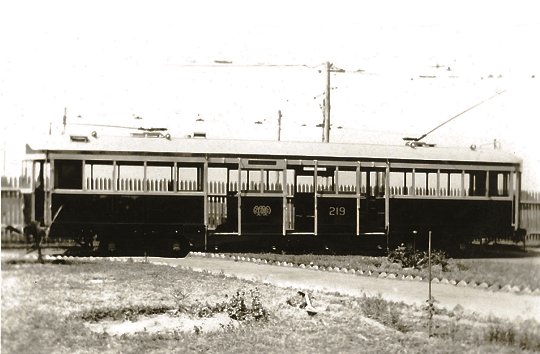
- Prototype W class 219 before entry to service in 1923. Note the equal width doorways in the drop centre, and the early and short-lived form of the M&MTB logo. In service the central door was underutilised, whereas the two outer doors suffered from congestion in peak periods. Two hundred trams were built to this design between 1923 and 1926.
- M&MTB official photograph.
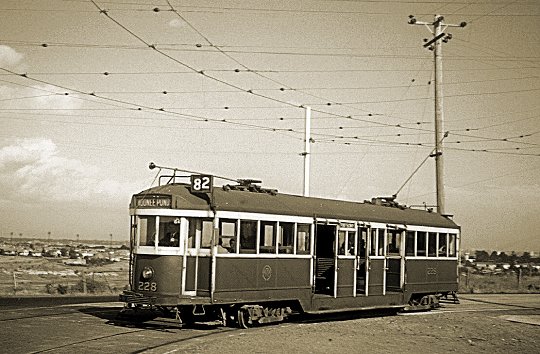
- W2 class 228 in Gordon Street, Maidstone on 8 January 1953. Number 228 was one of two hundred W class trams modified to the W2 design between 1928 and 1933. The two major alterations were rearrangement of the seating of the drop centre, and the changing of the door widths to ease congestion of the outer doors.
- Photograph courtesy Noel Reed.
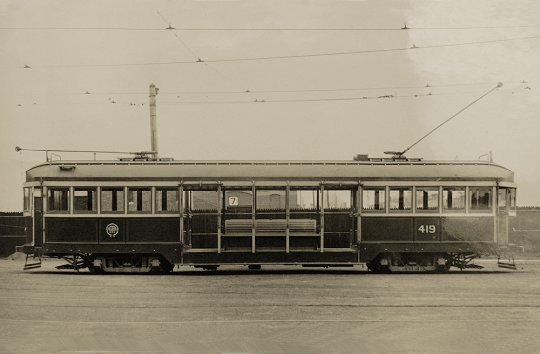
- Class leader W1 tram 419 in 1925. The thirty trams of the W1 class were a modification of the basic W class design with the objective of improving passenger loading time. While successful from this perspective, the open drop centres were not popular in Melbourne’s frequently inclement weather. Twenty-six of the W1 class were modified to the W2 class design between 1936 and 1937, while the remaining four were modified to the SW2 class design with sliding power operated doors in 1938.
- M&MTB official photograph.

- SW2 class 426 in Wallen Road Hawthorn, outside Hawthorn Depot circa 1939. This was one of four W1 class trams converted in 1938 to a closed saloon design with power operated sliding doors, to test features of the proposed SW6 class design in traffic. This was the final iteration of the W class design family produced under the direction of T.P. Strickland before his retirement as Chief Engineer.
- From the Ray Pearson Collection, courtesy of the TMSV.
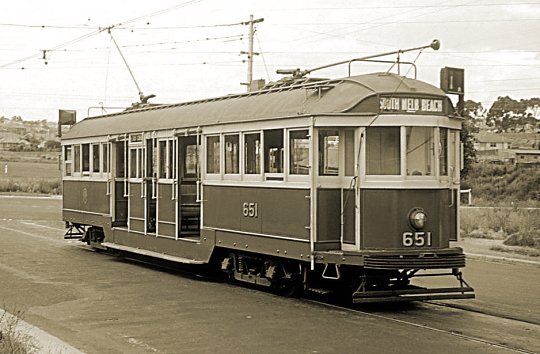
- W2 class 651 at East Coburg terminus in 8 January 1955. The four hundred and six W2 class trams would be the backbone of Melbourne’s tram system for over four decades, the final W2 not being withdrawn from regular service until 1987. Number 651 is one of the one hundred and eighty trams built new as a W2 class.
- Photograph courtesy Noel Reed.
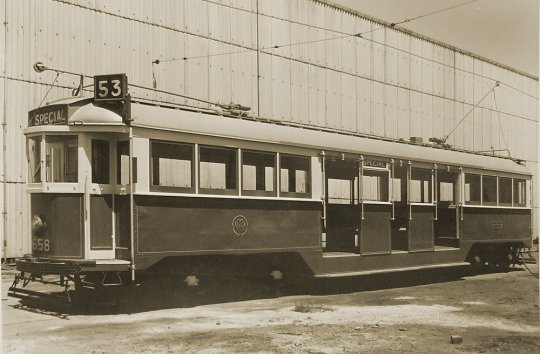
- An undated view of W3 class 658 at Preston Workshops. Sixteen W3 class trams were built between 1930 and 1934. A direct development of the W2 class design, these trams were unpopular with passengers due to the increased internal and external step heights necessary to accommodate the larger wheels used for this design. They were equally unpopular with drivers due to their lacklustre acceleration and braking performance, as well as the step down from the saloon into the driver’s cab.
- M&MTB official photograph.
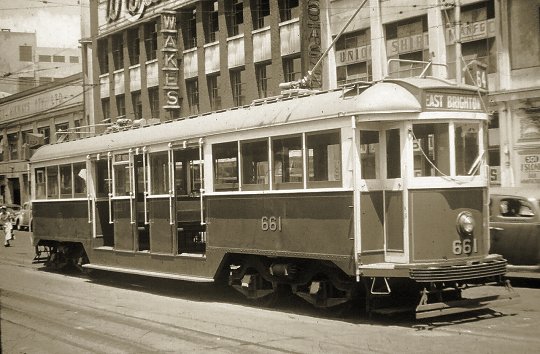
- W3 661 at the Franklin Street shunt in Swanston Street, about to depart to East Brighton on 19 January 1953. The W3 class trams suffered from fatigue cracking in their No 9 bogies due to a design flaw, which was not uncovered until the 1960s. This factor, together with the relatively small number in the class, a reduction in the number of trams required to maintain services, and their general unpopularity led to the withdrawal of all W3 class trams by April 1969. However, many of the trams were not disposed of until 1976.
- Photograph courtesy Noel Reed.

- W4 672 in Victoria Street Melbourne on 19 January 1953. The five W4 class trams were built between 1933 and 1935. These were the first wide-bodied W class trams built, using the same running gear as the preceding W3 class trams. While the design reduced step heights to acceptable levels, they suffered from many of the same shortcomings as the W3 class design. However, like the W3 class, the W4 class trams were good enough to remain in traffic for over three decades. All five W4 class trams were withdrawn by October 1968.
- Photograph courtesy Noel Reed.
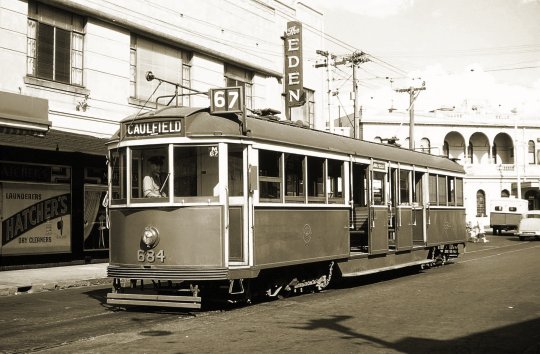
- An undated view of CW5 class 684 at the Acland Street terminus in St Kilda. The five trams of this class, built in 1934 and 1935, were the least successful of all W class designs. Using recycled Brill 22E maximum traction bogies, they were slow and rolled excessively. Note the chain attaching the bogie to the car body – the purpose was to prevent the Brill 22E bogie swivelling and ripping out the motor leads in the not infrequent event of a derailment of the lightly loaded pony wheels. All these trams were rebuilt into the standard W5 class after a serious accident in 1956.
- Photograph courtesy Noel Reed.
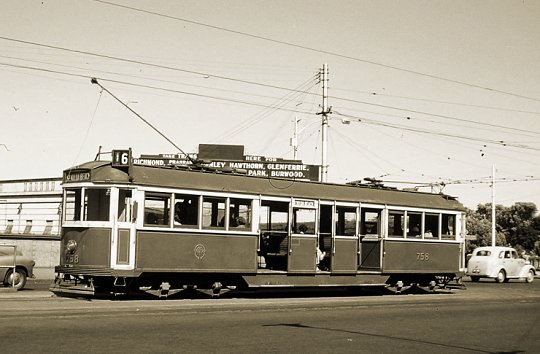
- W5 class 758 approaching Princes Bridge from the north on 17 January 1954. One hundred and twenty of these trams were built between 1935 and 1939 for the resumption of the cable tram conversion program. The body design was derived from the previous CW5 class, while the No 15 hornless trucks were developed from the No 9 trucks used in the W3 and W4 classes. The new truck design was both quiet and smooth riding, and offered superior braking performance due to its use of two brake shoes on each wheel. This design was the basis for the sliding door trams of the follow-on SW5, SW6, W6 and W7 classes – the last of which was not built until 1956.
- Photograph courtesy Noel Reed.
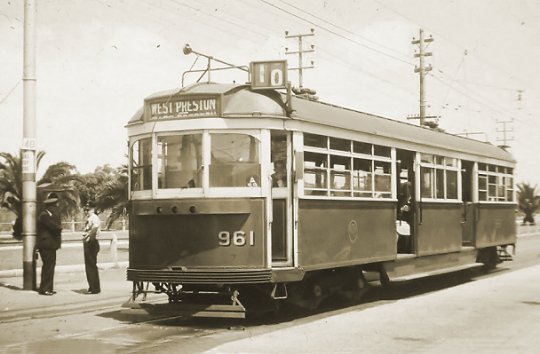
- SW6 class 961 in St Georges Road on 19 January 1953. These trams were the first of the W class design family that were not produced under Strickland’s regime, but the derivation from his W5 class is readily apparent. The only major external departures from the W5 class design are the sliding doors and the less than successful dash canopy lighting, which would be replaced by a standard headlight not long after this photograph was taken. Trams of this design are still running on City circle services in 2014.
- Photograph courtesy Noel Reed.
Keeping the cable trams running
While the General Scheme was being implemented, the remaining cable tram routes could not be neglected, as they would have to be kept in service. This gave Strickland a considerable challenge, as his priority was to push the conversion to electric traction as rapidly as possible, and minimising expenditure on maintaining a fully depreciated asset.
By this time much of the cable tram rail was heavily worn after close to four decades in service. To avoid the expense of replacement, in 1925 Strickland obtained an improved Woods-Gilbert rail planer to re-profile the rail on routes that were not slated for early conversion, such as the Port Melbourne and Brunswick routes. Re-profiling removed corrugations and irregularities in the rail surface, particularly at rail joints where wear was heaviest, providing a smoother ride.
One benefit of extensive rail re-profiling was a reduction in fuel consumption at cable engine houses. The reduced rolling resistance of the smoother track meant that less power was required to haul the cable trams, resulting in a cut in fuel usage in the engine house boilers.
Where sections of rail were too heavily worn to benefit from re-profiling, recycled rail from closed cable tram routes was used to extend the life of the track.
Planning of the conversion of the Swanston Street cable routes by Strickland resulted in the construction of the last cable tram track in Australia, in Lonsdale Street between Swanston Street and Elizabeth Street. This was used for through-routing of cable trams to the Elizabeth Street routes during the conversion of the northern end of Swanston Street. After the conversion of the rest of Swanston Street, the Lonsdale Street track was used as the terminus for West Melbourne cable trams, reducing the pressure on the busy Elizabeth Street terminus at Flinders Street.
Strickland also introduced motor omnibuses to support the cable tram conversion program, ensuring that passenger services continued despite the disruptive engineering works occasioned by the cable tram conversion works. Almost by default, the M&MTB became the largest bus operator in Victoria.
He also supervised the less glamorous work of rehabilitating the poorly constructed electric tramlines of the former Hawthorn Tramways Trust. Due attention was also paid to implementing electrolysis control systems across the entire network to prevent damage to utilities, primarily gas and water pipes and telephone cables.
Trams for hard times
The onset of the Great Depression in 1930 saw the halting of the conversion of cable tramways to electric traction as well as the construction of new electric tramways. Strickland was obliged to make severe staff cuts at Preston Workshops. However, he was able to keep new tramcar construction going, although at a greatly reduced volume. Over the four years from 1931 to 1933, the M&MTB built only 25 new trams. In contrast, during the peak year of 1928, Preston Workshops completed 79 tramcars.
During this period, the basic W class design shifted from the mixed timber and steel frames of the W2 class, to the all steel frames of the W3, W4 and CW5 classes. Not only were these cars about two tonnes lighter than their predecessors, reducing operational power consumption, the lighter steel frames significantly reduced the build cost. Each of these classes made use of components recycled from scrapped tramcars, chiefly wheel and axle sets. The exception was the CW5 class, whose five trams recycled the bogies, motors and electrical control equipment from scrapped maximum traction cars.
For a variety of different reasons [6], the performance of the 26 trams of the W3, W4 and CW5 classes were disappointing in traffic. The resumption of the cable tram conversion program in 1935 saw the delivery of the first trams of the W5 class, for the Elizabeth Street routes. The W5 cars were a synthesis [7] of the best features of the W3, W4 and CW5 designs, producing a highly successful type that would eventually number 125 tramcars [8]. It also formed the basis of the follow-on SW5, SW6, W6 and W7 class trams, which continued to be built until 1956. Some examples of the latter types are still in use today [9] on the heritage City Circle route – a tribute to the engineering department of the M&MTB under Strickland’s direction.
A sound foundation
To place Strickland’s achievements into perspective, over a period of seventeen years he established the core of Melbourne’s tramway system that persists to this day. The key measures of his success were:
- construction of 40.7 km of new electric tramway;
- conversion of 47.8 km of cable tramway to electric traction;
- implementation of a major tramway workshops at Preston; and
- design and building of 572 new passenger trams.
By any stretch of the imagination, this was a major career achievement for any engineer.
The State Government also appointed Strickland to the Metropolitan Town Planning Commission from 1922 to 1929. The Commission was responsible for developing recommendations for the implementation of consistent town planning regulations for Victoria, although legislation was not passed until 1944.
Due to ill-health, Strickland resigned from the M&MTB on 13 August 1938. The M&MTB did not appoint a new Chief Engineer to replace him. Instead, the heads of each engineering department would report directly to the Chairman of the Board. The next M&MTB Chief Engineer – D.H. Eakins – was not appointed until 1952.
War service
After his M&MTB service, Strickland worked for a time as a consulting engineer. It was during this period he applied for patents in both Australia and the United States for the design of railway and tramway crossings. This work is still referenced as prior art in patents in the same field granted less than ten years ago.
In December 1941 Strickland was appointed to the Board of the State Electricity Commission of Victoria (SECV). Strickland’s engineering and management expertise was highly regarded, and his input was key to wartime development of the Kiewa and Newport power stations, as well as extensions to the Morwell briquette factory.
The demands of the wartime economy saw the Federal Government appoint him to the Board of Business Administration of the Department of Defence in October 1943. This body was responsible for all business matters affecting defence services – a critical role in Australia’s war effort. Strickland held this position until just before the end of the Second World War in August 1945.
He finally retired from the SECV in December 1945. Strickland died on 3 March 1955 at his residence Dysart in Washington Street, Toorak, and was survived by his wife and three daughters. While Strickland’s General Scheme for the development of the Melbourne tramway system was never fully realised, he left an enduring mark on our city in the electric tram system that serves our people to this day, as well as that distinctly Melbourne icon, the W class tram.
Bibliography
Australian Town and Country Journal (1888) Obituary, 9 June 1888
Coleman, E.T., et al (1994) Survey Practice Handbook Victoria, Surveyors Registration Board of Victoria
Cross, N., Budd, D. & Wilson, R. (1993) Destination City Fifth Edition, Transit Australia Publishing
Evening News (1902) Government Gazette, 4 February 1902
Home, R.W, Sherrat, T. and Young, V. (1995) Physics in Australia to 1945, Australian Science and Technology Heritage Centre
ICS Reference Library (1923) Construction and Equipment of Electric Tramways and Railways, International Correspondence Schools Ltd
IEEE Xplore, Tom Percival Strickland, Institute of Electrical and Electronics Engineers
Keating, John D. (1970) Mind the Curve! Melbourne University Press
Mackmeikan, I. (1956) Melbourne Cable Tramways, Melbourne & Metropolitan Tramways Board
Melbourne & Metropolitan Tramways Board (1920-1939) Annual Reports
Melbourne & Metropolitan Tramways Board (1922) Interim report Upon the General Scheme for the future development of Tramways in Melbourne and Suburbs
News (1932) Tramwaymen Confer in Adelaide, 12 September 1932
Sunday Times (1897) University II defeat North Sydney II, 21 February 1897
Sydney Morning Herald (1896), Lawn Tennis – Sydney University Tennis Club, 14 April 1896
Sydney Morning Herald (1903), Marriage Notices, 9 May 1903
Sydney Morning Herald (1921) Auction Sales, 15 December 1921
Sydney Morning Herald (1945) Defence Board Appointments, 2 August 1945
The Advertiser (1943) Change in Personnel of Defence Business Board, 20 October 1943
The Argus (1921) Tramway Appointment, 5 August 1921
The Argus (1921) Tramway Extensions, 1 October 1921
The Argus (1923) Flemington Tram Collision, 26 September 1923
The Argus (1925) Remodelling Tram Rails, 16 May 1925
The Argus (1925) St Kilda Road Trams, 5 June 1925
The Argus (1925) Electric Tram Extension, 21 August 1925
The Argus (1934) Trams are better than Trolley Buses, 21 July 1934
The Argus (1938) Engineer Resigns, 12 August 1938
The Argus (1941) Personal, 16 December 1941
The Argus (1945) New Part Time Member of SEC Appointed, 7 December 1945
The Sydney Mail (1897) A Promising Student, 30 October 1897
Publications
The following is a partial list of publications authored by Strickland.
Strickland, T.P., and Russell, L. (1934) ‘Metropolitan and Provincial Tramways’, in 100 Years of Engineering in Victoria, The Institution of Engineers Australia
Strickland, T. P. (1934), ‘Use of the Trolley Slide by the M&MTB’, in Proceedings of the Australian & New Zealand Tramways Conference, Fourth Conference Sydney March 1934
Strickland, T.P. (1914-15) ‘The heating of cables in service’, Electrical Association of Australia. Proceedings, 1 (1914-15), 187-226.
Strickland, T.P. (1910) ‘Mr. James Barr’s experiments upon the flow of water over triangular notches’, Engineering (London) v. 90, (October 1910), p. 598
Strickland, T.P. (1908) ‘The Operation and Maintenance of Storage Batteries’, Australian Mining Standard (Melbourne) v. 40 1908 p. 585-588, 612, 640-641
Strickland, T.P. (1906) The Flow of Water through Sharp-edged Orifices, Sydney University Engineering Society
Strickland, T.P. (1904) The three phase generation, transmission, and conversion system of the Sydney electric tramways, Sydney University Engineering Society
Coker, E.G. and Strickland, T.P. (1902) On the measurement of water by a small venturi meter, Canadian Society of Civil Engineers
Barraclough, S.H.E. and Strickland, T.P. (1897) ‘Experimental investigation of the flow of water in uniform channels’, Royal Society of New South Wales Journal and Proceedings, 31 (1897), 356-376
Patents
Strickland, T.P., et al (1940) Tramway, Railway and Like Crossings, US 2214489A
Footnotes
[1] Dun Aros still exists at 10 The Crescent Manly.
[2] Founded in 1821, Greens Fuel Economizer Company is now trading as Greens Power Equipment.
[3] In London, the men who worked at these transition points were known as ‘ploughmen’.
[4] The bogie drop-centre tram design originated in 1906 in New Zealand with the Boon cars built for Christchurch. The basis of the design consists of two closed end-saloons above the bogies, with the intervening frame lowered to reduce the step height into the tram, as the key characteristic of the design was centre loading of passengers. The central part of a drop-centre tram in earlier years was open or semi-open – it was only with the Melbourne SW6 and Sydney R1 classes that the saloons were extended into the central portion of the tramcar.
The bogie drop-centre tramcar was a peculiarly Australasian regional design, with very few examples appearing outside the Australia or New Zealand.
[5] The SW2 class was the last variation of the basic W class design produced under Strickland’s management. In 1938, the last four unmodified W1 class trams (numbers 426, 432, 436 and 478) had their open drop centres replaced with a closed saloon fitted with two sliding doors on each side of the car, to test in traffic the internal car layout of the drop centre for the proposed SW6 class trams.
Two W2 class trams – 644 and 275 – were rebuilt to a modified version of the SW2 design in 1953 and 1955 respectively after receiving serious accident damage. These were to have been the prototypes for the mass conversion of the 406 cars of the W2 class to provide a comparable level of comfort to contemporary W6 class design. The conversion program did not proceed due to lack of capital funding.
[6] In an attempt to produce a quieter and smoother riding tramcar, the W3 and W4 class trams were equipped with hornless No 9 trucks fitted with 33" wheels. In this they were successful, although they suffered from slower acceleration than earlier W class trams, as they were not equipped with higher power motors to offset the larger wheel size.
Unlike earlier truck designs, the No 9 trucks were fitted with truck-mounted brake pistons which offered relatively poor braking performance compared with the earlier W class trams, which were fitted with a single body mounted piston operating via brake rigging. This poorer brake performance made them unpopular with drivers.
The W3 class cars sat high on their trucks, leading to a high step height, which made them unpopular with passengers. This was addressed in the later W4 class by setting the wider body lower on the trucks. However, the projection of the large 33" wheels into the space of the saloon meant rearranging the seating to cover the wheel space, reducing the number of seats from the 52 of the W3 class to 48.
However, in order to reduce the overall width of the design, W4 class cars had a recessed step, which made it difficult to for the driver to observe alighting passengers via his side mirror.
All the W4 class cars were withdrawn by October 1968, while the remaining W3 class cars were removed from service by April 1969.
The CW5 class resulted from a plan to build new tramcars fitted with the traction equipment and running gear of the 39 maximum traction bogie trams of the C, D, E, N and P classes inherited from the Prahran & Malvern Tramways Trust and the Hawthorn Tramways Trust.
However, the greater width of the CW5 class cars over the previous maximum traction designs meant that they rolled excessively from side to side. The CW5 class cars were also sluggish performers in traffic, with poor acceleration. As a result, the construction order was stopped at five trams, ensuring the survival of many of the old tramway trust maximum traction cars to this day.
After an accident in 1956 which resulted in a CW5 class tram rolling on to its side, all five cars were immediately withdrawn for conversion to W5 class, using surplus components from the curtailed W7 class construction program.
[7] The W5 design was based on the body style of the CW5 class cars, but replaced the maximum traction Brill 22E trucks with hornless No 15 trucks with 28" wheels, while the two 65 horsepower motors of the CW5 class were replaced with four 40 horsepower motors. Though of similar design to the No 9 trucks with 33" wheels, of the W3 and W4 class trams, the No 15 trucks did not have truck-mounted brake pistons, maintaining the single body-mounted brake piston of the CW5 class cars.
Due to its superior truck design, the W5 class was quiet and smooth riding, with superior braking performance to all previous W class trams. Furthermore, W5 class cars had better acceleration than all other W class trams due to their light weight and superior power-to-weight ratio.
The smaller wheel size meant that the step height was less than the unpopular W3 class, while it dispensed with the recessed step of the W4 class, increasing passenger safety. The W5 class also seated 52, four more than the W4 and CW5 classes.
[8] The W5 class consisted of 120 new-build cars, plus the 1956 conversions of the five CW5 class cars.
[9] Two SW6 class trams – 946 and 959 – have recently been rebuilt and modernised with electronic control systems and have now been classified into the W8 class.
